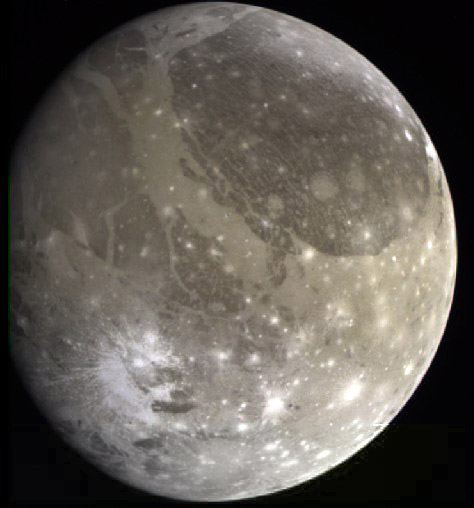Ganymede

Galileo spacecraft image of Ganymede taken 26 June 1996.
Ganymede is the largest satellite of Jupiter and of the entire solar system, slightly bigger even than Mercury (but with only half its mass) and three-quarters the size of Mars. It was discovered by Galileo and, independently, by Simon Marius in 1610.
Ganymede appears to have a differentiated internal structure, with a small molten iron or iron-sulfur core surrounded by a rocky silicate mantle with an icy shell on top. Its surface is a roughly equal mixture of two types of terrain: very old, highly cratered dark regions, and somewhat younger, lighter regions marked with an extensive array of grooves and ridges. Groove ridges as high as 700 meters (2,000 feet) have been observed stretching for thousands of kilometers. Their origin is clearly of a tectonic nature, but the details are unknown. In this respect, Ganymede may be more akin to Earth than is either Venus or Mars, though there are no signs of recent tectonic activity. The Galileo spacecraft discovered that Ganymede has a magnetic field.
Evidence for a tenuous oxygen atmosphere on Ganymede, like that of Europa, has been found by the Hubble Space Telescope. Similar ridge and groove terrain is seen on Enceladus, Miranda, and Ariel. The dark regions are similar to the surface of Callisto. Extensive cratering is seen on both types of terrain. The density of cratering points to a surface age of 3 to 3.5 billion years, similar that of to the Moon. Craters both overlay and are cross-cut by the groove systems showing that the grooves are quite ancient, too. Relatively young craters with rays of ejecta are also visible. Unlike the Moon, however, the craters are quite flat, lacking the ring mountains and central depressions common to craters on the Moon and Mercury. This is due to the relatively weak nature of Ganymede's icy crust, which can flow over geologic time and thereby soften the relief. Ganymede has its own magnetosphere, embedded within Jupiter's huge one, that is probably generated in a similar way to Earth's, as a result of motion of conducting material in the interior.
Galileo Regio is a prominent, dark, oval region, about 3,200 kilometers across, centered approximately at latitude +36° and longitude 138°. Gilgamesh is the largest preserved impact basin on Ganymede, with a rim 580 kilometers in diameter surrounding a roughly 300-kilometer-wide smooth central depression. An ejecta blanket and secondary crater chains blasted out from the basin are visible out to approximately 500 kilometers from the basin center.
| discovery | Jan 11, 1610, by Galileo Galilei |
| semimajor axis | 1,070,410 km (665,260 mi) |
| diameter | 5,262 km (3,270 mi) |
| equatorial diameter (Earth = 1) | 0.413 |
| mass (Earth = 1) | 0.025 |
| mean density | 1.94 g/cm3 |
| surface gravity (Earth = 1) | 0.146 |
| escape velocity | 2.74 km/s (9,864 km/h 6,131 mph) |
| orbital period | 7.155 days (7 d 3 h 43 min) |
| orbital eccentricity | 0.001 |
| orbital inclination | 0.204° |
| axial period | synchronous |
| albedo | 0.43 |
| surface temperature | -156°C (-249°F) |
| surface composition | dirty ice |


